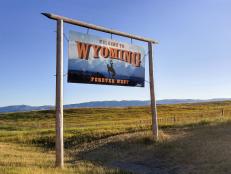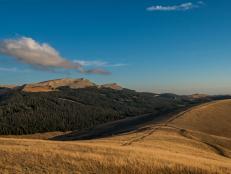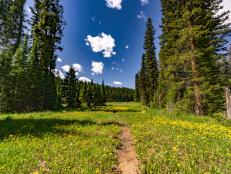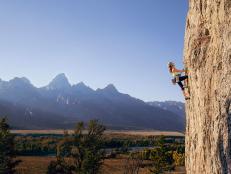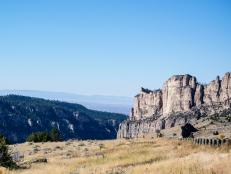Breathtaking Beauty of Wyoming
With two national parks, eight national forests, numerous state parks and recreation areas, Wyoming has more than its fair share of stare-inducing scenery. Get your oohs and ahs ready.

Related To:
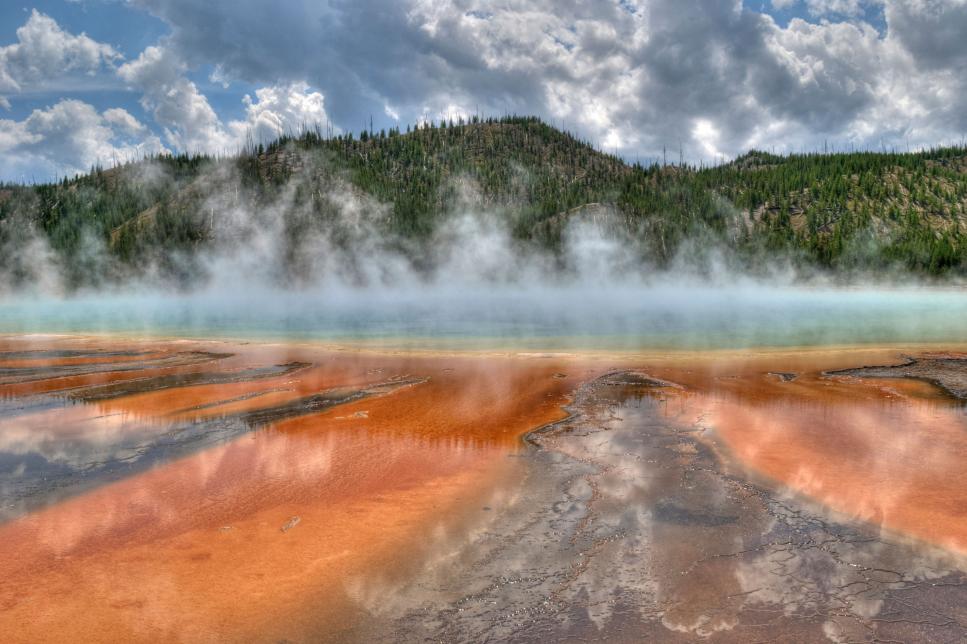
Photo By: Curtis Akin / NPS
©Maurice Northrup / Shutterstock
Photo By: Wyoming Office of Tourism
Photo By: Tobin Akehurst / Shutterstock
Photo By: NPS / Jacob W. Frank
Photo By: Wyoming Office of Tourism
Photo By: Albany County Tourism Board
Photo By: Wyoming Office of Tourism
Photo By: Wyoming Office of Tourism
Photo By: Wyoming Office of Tourism
Photo By: NPS / Jacob W. Frank
Geothermal Nirvana
When we think of Wyoming, we cannot help but think of Yellowstone National Park. It was our first national park, established in 1872, and it sits atop an active supervolcano. This grumpy downstairs neighbor lets his presence be known through the thousands of otherworldly hydrothermal sites around the park, including hot springs, steam vents and active geysers. One of the most photographed: Grand Prismatic Spring. The thermophiles (heat-loving microbes) living in the spring lend it a rainbow beauty. Another favorite site is Mammoth Hot Springs, with its unusual calcium deposits. And let us not forget Old Faithful, the reliable cone geyser that consistently erupts every one or two hours, reaching heights up to 184 feet.
Devils Tower
Geysers and hot springs aren’t the only dramatic contributions volcanos have made to Wyoming's landscape. The 1,267-foot Devils Tower is made of igneous rock, created as magma pushed up from the earth then cooled into hexagonal columns. This geologic giant was the first national monument in the country and is a sacred site to Native American tribes. Interestingly, geologists think the Tower formed at the same time as the Rocky Mountains—about 65 million years ago—and was made visible millions of years later through the erosion of the surrounding landscape. Devils Tower's thousand-plus feet are imposing from below, but this is also a favorite spot for rock climbers seeking a loftier perspective. The same is true of its southwestern cousin, Boar's Tusk: a 400-foot lamproite volcano core residing outside Rock Springs.
Looking Up From Canyons
Speaking of perspective, numerous canyons in the state offer sensational vantage points. Take US 20 from Shoshoni toward Thermopolis and drive through ancient Wind River Canyon, marveling at its 2,500-foot walls. Admire Devil's Gate, the 370-foot-deep cleft in the Sweetwater Rocks carved by Sweetwater River in Natrona County. The Green River carpets the bottom of dramatic Flaming Gorge, traversing southern Wyoming and northern Utah. Near Lander, the red sandstone of Red Canyon is set off in the summer by colorful, wildflower-laden meadows.
Looking Down From Mountains
If you aren't already gasping for air from the strenuous climb, the views from the top of Wyoming's peaks will surely take your breath away. There are numerous peaks in Wyoming for those 360-degree views we work for. Avalanche Peak in Yellowstone is a popular 4-mile trek, ascending 2,100 feet during the first half of the hike. A few-mile favorite in Bighorn is the 3,000-foot ascent to Cloud Peak. Longer, more arduous journeys include the infamous climb to the peak of Grand Teton, standing more than 13,000 feet. The highest peak in Wyoming is Gannett Peak in the Wind River Range, one of the most difficult mountaineering challenges in the country.
Wildlife
Wyoming could easily be called "Wild-oming." With fewer than 600,000 humans and half the land protected one way or another, there is ample space for the hundreds of Wyoming species of mammals and birds. Bison, bighorn sheep, mountain lions, bears, golden and bald eagles—the list is endless. We can see them all across the state but visiting one of the parks or forests is hedging our bets. Yellowstone's Lamar Valley is nicknamed "the American Serengeti" for its plentiful residents, which include wolves, bison, moose and coyote among many, many others.
Wildflowers
Wyoming has a long wildflower season that brings hundreds of varieties to its meadows and hillsides. From April to September—depending on the preceding winter—the regions and elevations have their own offerings that arrive at specific times of the year. Yellowstone's steer's head, glacier lily and yellow bells can be seen in May. The Bighorn National Forest viewing season is usually June, when the meadows erupt with silvery lupine, sego lily and shooting star. Grand Teton National Park is divided into three zones for wildflower viewing: The sagebrush valley offers skyrocket gilia and Indian paintbrush; the forest floor is loved by fireweed and monkshood; and the small flowers of the alpine zone include forget-me-not and sky pilot. The valley flowers bloom early in the season around June, while the higher elevations wait for warmth, beginning in August.
Winter Wonderland
The self-same Wyoming mountains and valleys that will be covered in the vibrant drapery of wildflowers in a few months are blanketed in snow for a huge chunk of the year, offering a stark contrast to the evergreens below and azure skies above. It is no wonder Wyoming is a favorite spot for cross-country skiers, snowshoers and alpine mountaineers, who can well appreciate the dramatic view afforded by this particular season in this particular place. And wherever we find ourselves standing in Wyoming, a range nearby awaits exploration or admiration: the Absaroka, Grand Tetons, Wyoming and Wind River ranges in the West; the Bighorns in the North; and the Snowy Range in Medicine Bow-Routt National Forest in the Southeast.
Looking Back
While long-abandoned, dilapidated buildings may not sound like places dripping with splendor, there is existential beauty in examining where we've been. Well, maybe not us precisely, but the residents and shopkeepers of the late 1800s and some notorious visitors such as Butch Cassidy. Old Trail Town is a representation of an Old West town, reconstructed from a collection of historic structures and artifacts from around the West and assembled on the site where Buffalo Bill laid out the original town of Cody. If you prefer your Old West inhabited, the town of Buffalo has a wonderful collection of historic buildings still in use, including the Occidental Hotel, originally constructed in 1880. Nearby Sheridan's Historic Main Street features buildings dating from the 1910s and 1920s in use today by shops and restaurants, and the town boasts 46 buildings on the National Registry of Historic Places.
Powwows
The name "Wyoming" is derived from a Native American word describing the landscape. We’ve gained perspective on much of Wyoming's natural beauty, and now we look to the captivating cultural celebrations of Wyoming's original residents. The Wind River Indian Reservation is the seventh largest in the country, and Northern Arapaho and Eastern Shoshone tribes reside here. Powwows take place both on the reservation and elsewhere in the state, are open to the public and are amazing to behold. Featuring skillful drumming, talented dancing and elaborate and painstakingly crafted regalia, these cultural celebrations and dance competitions draw dancers and drummers from all over North America. The largest—the Eastern Shoshone Indian Days, Ethete Celebration and Northern Arapaho powwows—occur annually during the summer on the reservation. Photography is generally welcome except during certain ceremonies and prayers, but inquire first.
Sunrises and Sunsets
During our Wyoming tour, we've looked out, but have we looked up? This area of the country offers some truly gorgeous sunsets and sunrises. Each region has its preferred spots, but the general rule is to find a vast expanse (meadow, lake) that is punctuated by a vertical object (mountain range, tree, barn), arrange your seat and settle in with your beverage of choice. The Grand Tetons are a natural choice as the dramatic backdrop, and favorite sunset spots include those from Schwabacher Landing, Snake River Overlook and ... oh, let's face it, probably about anywhere.
Starry Skies
With so much uninhabited land in Wyoming, light pollution in the state is incredibly low. That, coupled with Wyoming's high elevation and low humidity, means that night-sky enthusiasts are in star-studded heaven here. Regular sightings include meteor showers and the Milky Way, and even the aurora borealis is visible at times. If we want to be prepared, Dark Site Finder has a map. For help, tour companies offer stargazing excursions into the national forests and parks, excellent spots with even less light pollution and often higher elevation. How about Old Faithful battling it out with the Milky Way overhead? Yes, please.
